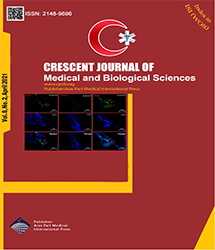
| Original Article | |
| The Relationship Between Clinical Presentation and the Type of Coronary Artery Involved in Patients With Acute Coronary Syndrome | |
| Mohsen Abbasnezhad1, Mohammadreza Taban Sadeghi1, Bijan Zamani2, Naser Khezerlou Agdam1, Razieh Parizad1, Amirreza Abbasnezhad3, Babak Nasiri1 | |
| 1Cardiovascular Research Center, Tabriz University of Medical Sciences, Tabriz, Iran 2School of Medicine, Ardabil University of Medical Sciences, Ardabil, Iran 3University of Tehran, Tehran, Iran |
|
|
CJMB 2021; 8: 138-143 Viewed : 3175 times Downloaded : 2446 times. Keywords : Acute coronary syndrome, Symptoms, Angiography, Coronary occlusion |
|
| Full Text(PDF) | Related Articles | |
| Abstract | |
Objectives: According to cardiologists" experiences, there is possibly a relationship between clinical symptoms and the type of coronary artery involvement in patients with the acute coronary syndrome (ACS). Given the significance of the issue, the present study was conducted to explore the relationship between clinical symptoms and the type of coronary artery involvement in ACS patients. Materials and Methods: In general, 720 ACS patients hospitalized in Shahid Madani hospital of Tabriz were enrolled in this descriptive, cross-sectional study from August 2011 to February 2012. Participants were selected by means of convenience sampling and according to inclusion criteria. Data collection tools were a demographic questionnaire and ACS indices. The results were analyzed using SPSS16 and P < 0.05 was considered statistically significant. Results: The findings showed that following the diagnoses through coronary artery angiography, 289 (40.1%), 201 (27.9%), 227 (31.5%), and 18 (2.5%) patients had single-vessel disease, two-vessel disease, three-vessel disease, and the left main disease, respectively. A total of 416 patients (57.8%) suffered from left anterior descending (LAD) disease while involvement rates were 142 (19.7%), 208 (28.9%), 8 (1.1%), 73 (10.1%), 17 (2.4%), and 21 (2.9%) patients for patent ductus arteriosus, obtuse marginal artery 2, obtuse marginal artery 1, diagonal 2, diagonal 1, right coronary artery (RCA), and left circumflex (LCX), respectively. Conclusions: Based on pathological findings, retrosternal pain was the most common symptom to all coronary occlusions regarding ACS symptoms. LAD, as the most involved vessel, had varying manifestations. Finally, referred pain to teeth was only observed in RCA involvement. The results can be helpful for timely and accurate diagnosis of cardiac patients who refer to emergency rooms and thus reduce the mortality rate by taking appropriate therapeutic measures. |
Cite By, Google Scholar
Google Scholar
PubMed
Online Submission System
 CJMB ENDNOTE ® Style
CJMB ENDNOTE ® Style
 Tutorials
Tutorials
 Publication Charge
Medical and Biological Research Center
About Journal
Publication Charge
Medical and Biological Research Center
About Journal
Aras Part Medical International Press Editor-in-Chief
Arash Khaki
Deputy Editor
Zafer Akan


















